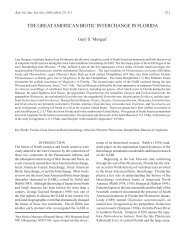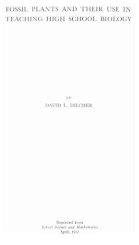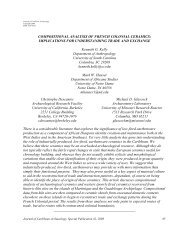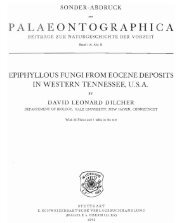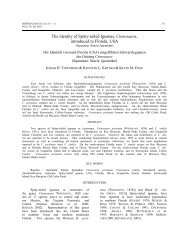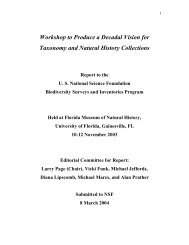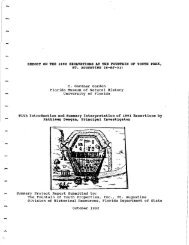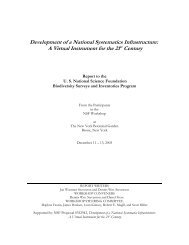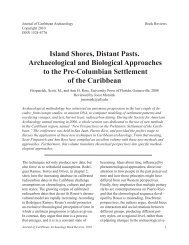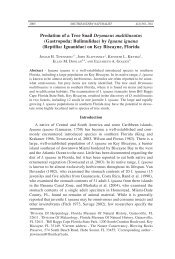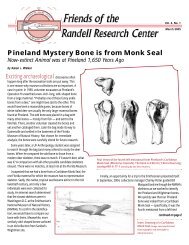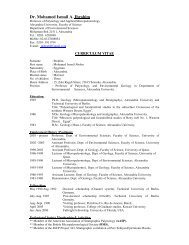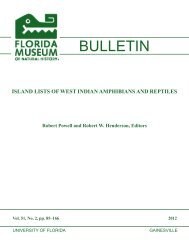Early angiosperms from the Lower Cretaceous of Jixi, eastern ...
Early angiosperms from the Lower Cretaceous of Jixi, eastern ...
Early angiosperms from the Lower Cretaceous of Jixi, eastern ...
You also want an ePaper? Increase the reach of your titles
YUMPU automatically turns print PDFs into web optimized ePapers that Google loves.
entire.Petiole about 4.5 mm long.Midvein distinct,<br />
about 0.4^0.5 mm in thickness; alternating<br />
secondary veins departing midvein at medium to<br />
wide angles, appear to branch 1/2 to 2/3 distance<br />
towards <strong>the</strong> leaf margin and joining with intramarginal<br />
vein.Tertiary and smaller veins thin,<br />
form a dense network <strong>of</strong> polygonal areoles.<br />
Holotype: SC10026, Plate V, 1B, 2; Fig.4G.<br />
Etymology: Xingxuephyllum, named in honor <strong>of</strong><br />
Pr<strong>of</strong>essor Xingxue Li <strong>of</strong> <strong>the</strong> Nanjing Institute <strong>of</strong><br />
Geology and Palaeontology, Academia Sinica for<br />
his contributions to <strong>the</strong> study <strong>of</strong> <strong>the</strong> early <strong>angiosperms</strong><br />
<strong>from</strong> NE China during <strong>the</strong> 1950s to<br />
1990s; jixiensis, <strong>the</strong> locality <strong>of</strong> <strong>the</strong> new species.<br />
Discussion: The leaf is probably connected organically<br />
with <strong>the</strong> in£orescence <strong>of</strong> Xingxueina heilongjiangensis<br />
gen.et sp.nov.(see below).Since <strong>the</strong><br />
joint part <strong>of</strong> <strong>the</strong> present leaf to <strong>the</strong> in£orescence is<br />
not well-preserved, <strong>the</strong> authors will give a new<br />
taxon name to <strong>the</strong> present leaf.However, names<br />
<strong>of</strong> <strong>the</strong> leaf and in£orescence will be combined to<br />
<strong>the</strong> same taxon when better material showing<br />
clear organic connection mentioned above has<br />
been found.Morphologically, <strong>the</strong> present leaf is<br />
more or less similar to Shenkuoa, but <strong>the</strong> latter<br />
has triangular and slightly acute apex which is not<br />
shown in <strong>the</strong> present species.Moreover, Shenkuoa<br />
is incompletely preserved in its leaf base, which is<br />
di⁄cult to compare to <strong>the</strong> present species.<br />
Material: 2 specimens.<br />
Locality and horizon: Ibid., in <strong>the</strong> W-B section<br />
bed No.47.<br />
Genus Xingxueina Sun et Dilcher, 1997<br />
Type: Xingxueina heilongjiangensis Sun et Dilcher<br />
Xingxueina heilongjiangensis Sun et Dilcher<br />
Plate V, 1A, 3^5; Plate VI, 1^6; Fig.4G<br />
Synonyms:<br />
Plate IV.<br />
G. Sun, D.L. Dilcher / Review <strong>of</strong> Palaeobotany and Palynology 121 (2002) 91^112 105<br />
1995 Xingxueina heilongjiangensis Sun et Dilcher; Sun, p.<br />
429, text-¢g.9^2, 8 [nomen invalidum].<br />
1996 Xingxueina heilongjiangensis Sun et Dilcher; Sun and<br />
Dilcher, p.393, pl.2, ¢gs.1^6; text-¢g.1E [nomen<br />
invalidum].<br />
1997 Xingxueina heilongjiangensis Sun et Dilcher; Sun and<br />
Dilcher, p.137, pl.1, ¢gs.1^7; pl.2, ¢gs.1^6; text-<br />
¢g.2.<br />
Description: In£orescence elongate, about 4.2^4.6<br />
mm wide and more than 14 mm long (incomplete<br />
length preserved), consisting <strong>of</strong> numerous small<br />
£orets borne helically upon an axis.The peduncle<br />
or stock below <strong>the</strong> position <strong>of</strong> <strong>the</strong> £orets is<br />
smooth, slightly bent or arching, 1.2^1.5 mm<br />
wide by 20 mm long borne in <strong>the</strong> axil <strong>of</strong> a leaf.<br />
Florets subtended by bracts, 0.8U1.2 mm, £orets<br />
rounded, small, 1.1^1.5 mm in diameter and<br />
crowded helically upon axis.Structure <strong>of</strong> individual<br />
£oret not understood but pollen in situ have<br />
been found.Pollen nearly circular, 15^20 Wm<br />
in diameter, seemingly inaperturate, exine reticulate<br />
and tectate-columellate, muri more or less<br />
smooth, 0.3 Wm wide, net-like, areoles irregularly<br />
polygonal, about 0.2^1.0 Wm in diameter.<br />
Discussion: The present in£orescence is characterized<br />
by its small size, stout and longer peduncle,<br />
and in situ inaperturate pollen which di¡ers <strong>from</strong><br />
those known so far in <strong>the</strong> world.The present<br />
pollen bears some resemblance to Afropollis<br />
<strong>from</strong> Israel (Brenner, 1996) but di¡ers in having<br />
smaller areoles and smoo<strong>the</strong>r muri on <strong>the</strong> exine.<br />
Brenner (1996) reported on <strong>the</strong> oldest known angiosperm<br />
pollen <strong>from</strong> a core sample taken <strong>from</strong><br />
two wells with sediments <strong>of</strong> late Valanginian to<br />
late Hauterivian age, in Israel (Brenner and Bicko¡,<br />
1992).He reports that <strong>the</strong> earliest known<br />
angiosperm pollen consist <strong>of</strong> small, circular, inaperturate<br />
forms with tectate-columellate exine<br />
(Brenner, 1996), however, <strong>the</strong> pollen is known<br />
1^7. Zhengia chinensis Sun et Dilcher gen.et sp.nov.<br />
1, 2. Showing two incomplete leaves, Holotype SC10023, 10024.1.Bar = 0.5 cm.2.Bar = 0.33 cm.<br />
3^6.<strong>Lower</strong> cuticle (inside view), SC10023.<br />
3, 6.Stomatal zones, SEM0964, 0965.3.Bar = 30 Wm.6.Bar = 30 Wm.<br />
4, 5.Stomata in detail, SEM0966, 0967.4.Bar = 10 Wm.5.Bar = 10 Wm.<br />
7.Pits and uneven periclinal walls in lower cuticle (outside view), PB16776, SEM0673.Bar = 25 Wm.



